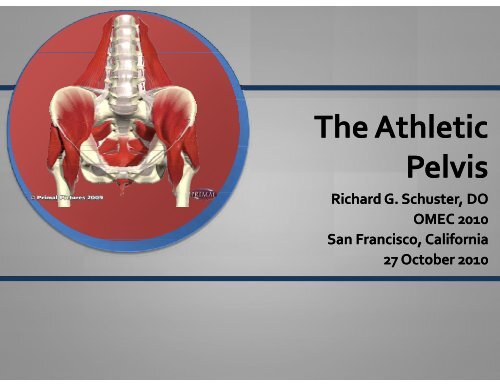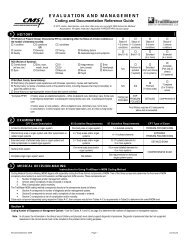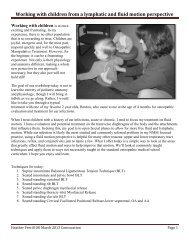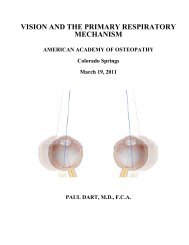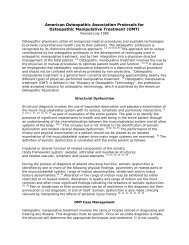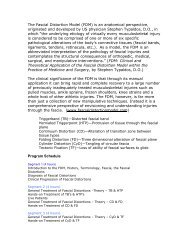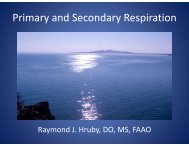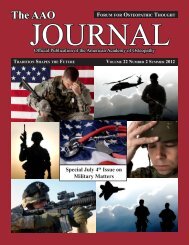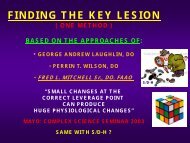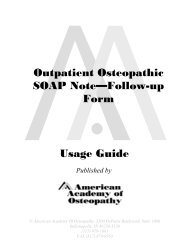The Athletic Pelvis - American Academy of Osteopathy
The Athletic Pelvis - American Academy of Osteopathy
The Athletic Pelvis - American Academy of Osteopathy
You also want an ePaper? Increase the reach of your titles
YUMPU automatically turns print PDFs into web optimized ePapers that Google loves.
<strong>The</strong> <strong>Athletic</strong><br />
<strong>Pelvis</strong><br />
Richard G. Schuster, DO<br />
OMEC 2010<br />
San San Francisco Francisco, Francisco Francisco, California<br />
27 October 2010
What What are are we we going going to do?<br />
We will review a case which brings to mind the differential<br />
diagnosis for groin pain in athletes athletes. athletes<br />
We will discuss the definitions <strong>of</strong> each diagnosis and the<br />
most t significant i ifi t hi historical hi t i l and d clinical li i l examination i ti<br />
findings.<br />
We will discuss the appropriate use <strong>of</strong> imaging studies to<br />
aid in the diagnosis.<br />
In the lab we will discuss the use <strong>of</strong> osteopathic manual<br />
medicine relating to the lumbar spine and pelvis.
Case I<br />
A 33 year old female presents with a 3 month history <strong>of</strong><br />
left lleft l ft sided id d anterior t i hip hi pain. i<br />
She has never been an athlete, , but 6 months ago g began g<br />
riding a bicycle to help her lose weight.<br />
She is 5’4”, 185#. She has lost 35lbs.<br />
Prior to this, she was not “athletically inclined.”<br />
She started at about 3 miles, but now typically rides more<br />
than h 100 miles il per week. k Her H long l rides id are up to 50 miles. il<br />
<strong>The</strong> pain came on gradually, g but has worsened to the point<br />
where she <strong>of</strong>ten must limit her rides.
Case I: history<br />
Initially the pain started after about 10 miles <strong>of</strong> riding, but<br />
now now begins begins within within the the first first mile mile and and she she can can only only go go 5<br />
5‐7 7<br />
before having to stop.<br />
It It i is sometimes ti present t with ith prolonged l d sitting, itti sometimes ti<br />
hurts with cough or sneeze.<br />
She does not have any back pain; she does not have any<br />
radicular pain.<br />
Does not wake her at night.<br />
She She is is very very angry angry because because she she is is afraid afraid she she will will start<br />
start<br />
gaining weight again.
Case I: examination<br />
Lumbar spine, SIJ and neurological exam are normal<br />
Abdomen: normal except obese and question <strong>of</strong> femoral<br />
hernia.<br />
Hip exam:<br />
Passive ROM intact, , but passive p flexion (140 (140°) 4 ) is painful. p<br />
Resisted Flexion/extension, abduction/adduction,<br />
internal/external rotation all 5/5 and without pain.<br />
Palpation: tender along superior pubic ramus ramus, , none over<br />
psoas psoas, , trochanteric or gluteal bursae
Groin pain in athletes<br />
Can be very difficult to diagnose<br />
due to very large differential:<br />
T12, L1, L2, L3, S3, S4<br />
dermatomes cross this area.<br />
Multiple p abdominal<br />
pathologies:<br />
Appendicitis, diverticulitis<br />
Aortic/iliac i ili<br />
aneurysm<br />
UTI, urolithiasis<br />
Ovarian cyst cyst, ectopic<br />
pregnancy, salpingitis salpingitis, ,<br />
prostatitis prostatitis, , testicular<br />
torsion, torsion torsion, epididymitis
Local<br />
Local musculosketal causes<br />
Can be divided into three<br />
potential subdivisions:<br />
Abdominal wall<br />
Rectus abdominus<br />
tendonitis<br />
tendonitis<br />
Groin hernia<br />
Inguinal Inguinal<br />
Femoral<br />
Femoral<br />
Sports hernia<br />
Ilioinguinal neuralgia<br />
Pel <strong>Pelvis</strong> Pel <strong>Pelvis</strong> is<br />
SIJ strain<br />
Iliolumbar strain<br />
Pubic bi ramus stress f fracture<br />
Osteitis pubis<br />
Cont’<br />
Hip Joint<br />
Capsular lesions<br />
AVN, OA, labrum<br />
Loose body<br />
Psoas bursitis<br />
Femoral neck/proximal<br />
femur stress fracture<br />
Avulsion fractures<br />
ASIS, AIIS, lesser<br />
trochanter trochanter (kids)<br />
(kids)<br />
Tendonitis Tendonitis<br />
Adductors<br />
P Psoas<br />
Sartorious<br />
Rectus femoris
So let’s look at<br />
some<br />
possibilities<br />
possibilities…
Differential:<br />
F Femoral F l neck k<br />
stress fracture f<br />
Who do we see this in?<br />
What are the symptoms?<br />
y p<br />
What do we find on examination?<br />
How would we treat it?
Femoral neck<br />
stress f fracture<br />
Treatment:<br />
If no actual fracture line: non‐ non<br />
weight bearing for likely 4<br />
weeks weeks.<br />
If fracture line:<br />
Compression side, 50%: ORIF<br />
Distraction side: ORIF<br />
ATHLETE MUST<br />
UNDERSTAND THAT THIS CAN<br />
BE A LIFE ALTERING EVENT!!!!
Differential:<br />
Pubic P PPubic bi ramus<br />
stress fracture f<br />
Who do we see this in?<br />
What Wh What are the h symptoms? ?<br />
What do we find on<br />
examination?<br />
How would we treat it?
Pubic ramus stress<br />
fracture<br />
Treatment is typically yp y<br />
non non‐weight weight bearing until<br />
able to walk without pain.<br />
Even if full fracture forms,<br />
d do not need d surgery<br />
because this is<br />
nontraumatic injury injury. injury<br />
Healing Healing is is typically typically in in six<br />
six<br />
months, but may not<br />
have full return to activity y<br />
for a year (I have seen this<br />
go out to two years).
Differential:<br />
Acetabular labral tears<br />
Who do we see this in?<br />
What are the symptoms?<br />
What What do do we we find find on<br />
on<br />
examination?<br />
How How would would we we treat treat it?<br />
it?
Acetabular<br />
Acetabular labral<br />
labral tear<br />
tear<br />
I have found many y<br />
respond well to<br />
combination combination <strong>of</strong><br />
OMM and PT.<br />
Surgical S Surgical i l correction i<br />
may be necessary,<br />
but very surgeon<br />
depe dependent. depe dependent. de t
Diff Differential: ti l<br />
Osteitis pubis p<br />
Who do we we see see this<br />
in?<br />
in?<br />
What are the<br />
symptoms? ?<br />
What do we find on<br />
examination?<br />
How would we treat<br />
it?
Osteitis<br />
Osteitis pubis<br />
pubis<br />
Sh Should ld be b self self‐limited lf li limited it d<br />
condition with relative<br />
rest. rest. May May respond respond to<br />
to<br />
OMM and/or PT.<br />
Responds very well to 11‐2<br />
2<br />
steroid injections, j but<br />
may need sclerosant<br />
injection.<br />
Surgery is reserved only<br />
f for f the h most recalcitrant li<br />
cases.
Differnetial:<br />
Differnetial :<br />
Sports p Hernia<br />
What the heck is a “sports hernia” anyway!?
Sports Hernia<br />
Tear <strong>of</strong> posterior wall <strong>of</strong><br />
inguinal inguinal canal canal ( (TrA TrA or<br />
conjoint tendon)<br />
or<br />
or<br />
Tear <strong>of</strong> external<br />
oblique q aponeurosis<br />
p<br />
causing dilation <strong>of</strong><br />
external inguinal ring.<br />
Differentiated from a true<br />
hernia in that there is no<br />
extrusion <strong>of</strong> abdominal<br />
material material through the<br />
abdominal wall.
Sports Sports hernia<br />
Most common in sports requiring dynamic lateral movement:<br />
soccer soccer, rugby rugby, hockey hockey, football football.<br />
Unilateral groin pain during activities, but if chronic may occur<br />
d during d i daily d il activities. ti iti<br />
Typically insidious in onset but may be related to acute event.<br />
Sudden Sudden movements movements <strong>of</strong>ten <strong>of</strong>ten exacerbate exacerbate the the pain pain. pain pain.<br />
Requires good palpation <strong>of</strong> inguinal ring, inguinal canal, pubic<br />
tubercle and mid mid‐inguinal inguinal inguinal region. region region. region<br />
Ultrasound may help in diagnosis.<br />
Treatment is usually surgical.
Differential:<br />
Ilioinguinal nerve<br />
entrapment<br />
p<br />
Who do we see this in?<br />
What Wh What are the h symptoms? ?<br />
What do we find on<br />
examination?<br />
How would we treat it?
Differential:<br />
Groin hernia<br />
We all know what these are, but they are <strong>of</strong>ten<br />
overlooked. l k d<br />
Three types: yp direct, , indirect and femoral.<br />
Pain is <strong>of</strong>ten related to activities that increase intra intra‐<br />
abdominal abdominal pressure pressure or or call call for for repeated repeated Valsalva Valsalva. Valsalva Valsalva.<br />
Initially pain may occur only during activity, but over time<br />
may y begin g to occur with even simple p trunk or hip p<br />
activities.
Direct inguinal<br />
hernia<br />
Comes Comes through the<br />
posterior posterior wall wall <strong>of</strong> the<br />
inguinal canal lateral to<br />
the border <strong>of</strong> the rectus<br />
abdominus abdominus.<br />
Usually secondary to<br />
weakness in fascia <strong>of</strong><br />
TrA. TA TrA TA .<br />
Th <strong>The</strong>se may b<br />
be<br />
symptomless except for<br />
noticing the bulge
Indirect inguinal<br />
hernia<br />
Failure <strong>of</strong> processus vaginalis<br />
to to close, close, thus thus originating originating at<br />
at<br />
the internal inguinal ring.<br />
Likely secondary to<br />
weakness or tear <strong>of</strong> the<br />
posterior wall wall <strong>of</strong> the inguinal<br />
canal more lateral than a<br />
di direct t h hernia, i i in th<br />
the presence<br />
<strong>of</strong> potentially patent<br />
processus processus vaginalis vaginalis. vaginalis vaginalis.
Femoral hernia<br />
This is what our patient actually had. <strong>The</strong> story story for the diagnosis<br />
i is quite it i interesting….<br />
t ti
Concluding Concluding thoughts<br />
thoughts<br />
<strong>The</strong> diagnosis <strong>of</strong> groin pain in athletes can be quite<br />
daunting. d ddaunting. ti<br />
However, , with a careful consideration throughout g the<br />
history and physical examination, a likely diagnosis can be<br />
arrived at, and treatment instituted.<br />
<strong>The</strong> thing to remember is that if the patient is not<br />
responding, p g, it should first call into question q not the<br />
treatment, but the diagnosis.
Primal Pictures<br />
Thieme Atlas <strong>of</strong> Anatomy<br />
Brianna Shook<br />
Kate Vitoritto<br />
Fran Hurley<br />
<strong>The</strong> many students who<br />
keep me questioning.<br />
My family for all their<br />
love and support.<br />
Thank you


